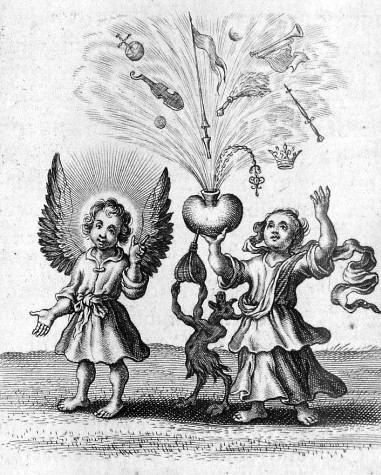1623 · Madrid
by SALAS BARBADILLO, Alonso Geronimo (ca. 1580-1635)
Madrid: widow of Cosme Delgado for Andres Carrasquilla, 1623. 8vo (147 x 89 mm). [8], 215, [1 blank] leaves. Woodcut printer’s device on title, 2 woodcut initials. (Discreet marginal repairs to foot of title and fol. D8, lightly washed, one or two residual stains, but a nice copy.) Green morocco gilt, covers with triple gilt panel and arabesque with central inlaid red morocco gilt quatrefoil, spine in six compartments similarly decorated and with gold-tooled title, turn-ins gilt, gilt edges, by Brugalla, 1945; morocco-edged slipcase. Bookplate of Kenneth Rapoport.***
First Edition, rare, of an unclassifiable Golden Age literary work by a peer of Cervantes, known for his cutting wit. The hero Don Diego avoids daylight throughout nine picaresque adventures on nine successive nights. Embodying the general neurotic depressiveness of Counter-Reformation Spain, “Salas' Don Diego chooses an out-of-the-way district of the city and in its most obscure corner, literally speaking, builds a house that is so completely defended from the rays of the sun that only the dimmest daylight ever penetrates its doors and windows. There our hero, or anti-hero, establishes himself, hiding carefully from daylight and the sun, to emerge only when the shadows of night have created the dark world in which he finds his existence. Don Diego decorates the inside of his house entirely in black and fills it with paintings and statuary representing nocturnal scenes and the aspects of life peculiar to the nighttime hour” (Peyton, p. 497). This “man-bat” roams the city by night, seeking amorous adventures and the “motley company of kindred adventurers,” (ibid., p. 506), often landing in macabre entanglements. “The principle of flight — flight of characters from themselves and from situations, a characteristic of the rogue novel — is also operative in Salas' book. It accounts for its episodic nature” (ibid, p. 485). Among the many digressions are 31 “jocular letters,” arbitrarily inserted between Adventures 2 and 3.
Salas' bizarre tales, written in a self-conscious and sophisticated literary style filled with zeugmas, puns and neologisms, had a mixed reception, being accused of lack of unity of style and content, although a second edition appeared the following year. Don Diego de Noche is now viewed as one of Salas’ best works, and its preoccupations a reflection of his time. The role of the city Madrid as a quasi-protagonist, the depictions of everyday life, and the matter-of-fact descriptions of actions or scenes that would traditionally have served as moral lessons — all these qualities are seen by modern scholars as elements of a transition away from the late baroque toward modern Spanish literature (cf. Laguna).
I locate two US copies (Boston Public Library and Hispanic Society).
Iberian Books B42992; Palau 286242; Salva 1973. Cf. Peyton, “Salas Barbadillo’s Don Diego de Noche,” PMLA 64, no. 3 (1949): 484–506; A. Laguna, [review of:] Alonso Jerónimo de Salas Barbadillo. Don Diego de noche. Ed. Enrique García Santo-Tomás. Madrid: Cátedra, 2013, Cincinnati Romance Review, Volume 38 (2015), 291-294. (Inventory #: 4404)
First Edition, rare, of an unclassifiable Golden Age literary work by a peer of Cervantes, known for his cutting wit. The hero Don Diego avoids daylight throughout nine picaresque adventures on nine successive nights. Embodying the general neurotic depressiveness of Counter-Reformation Spain, “Salas' Don Diego chooses an out-of-the-way district of the city and in its most obscure corner, literally speaking, builds a house that is so completely defended from the rays of the sun that only the dimmest daylight ever penetrates its doors and windows. There our hero, or anti-hero, establishes himself, hiding carefully from daylight and the sun, to emerge only when the shadows of night have created the dark world in which he finds his existence. Don Diego decorates the inside of his house entirely in black and fills it with paintings and statuary representing nocturnal scenes and the aspects of life peculiar to the nighttime hour” (Peyton, p. 497). This “man-bat” roams the city by night, seeking amorous adventures and the “motley company of kindred adventurers,” (ibid., p. 506), often landing in macabre entanglements. “The principle of flight — flight of characters from themselves and from situations, a characteristic of the rogue novel — is also operative in Salas' book. It accounts for its episodic nature” (ibid, p. 485). Among the many digressions are 31 “jocular letters,” arbitrarily inserted between Adventures 2 and 3.
Salas' bizarre tales, written in a self-conscious and sophisticated literary style filled with zeugmas, puns and neologisms, had a mixed reception, being accused of lack of unity of style and content, although a second edition appeared the following year. Don Diego de Noche is now viewed as one of Salas’ best works, and its preoccupations a reflection of his time. The role of the city Madrid as a quasi-protagonist, the depictions of everyday life, and the matter-of-fact descriptions of actions or scenes that would traditionally have served as moral lessons — all these qualities are seen by modern scholars as elements of a transition away from the late baroque toward modern Spanish literature (cf. Laguna).
I locate two US copies (Boston Public Library and Hispanic Society).
Iberian Books B42992; Palau 286242; Salva 1973. Cf. Peyton, “Salas Barbadillo’s Don Diego de Noche,” PMLA 64, no. 3 (1949): 484–506; A. Laguna, [review of:] Alonso Jerónimo de Salas Barbadillo. Don Diego de noche. Ed. Enrique García Santo-Tomás. Madrid: Cátedra, 2013, Cincinnati Romance Review, Volume 38 (2015), 291-294. (Inventory #: 4404)






![[Incipit:] A la muy Esclarecida Señora, mi Señora la Señora, Doña Isabel Salzedo Azcona, Rio, &c. Condesa de Gomara, &c., dignissima esposa del Señor D. Manuel Villavicencio ... Marques de Alcantara, del Cuerbo, &c. Señora, aun no perfectamente deliberado a presidir este primero publico rasgo de mi corto ingenio in este Celeste Theatro de Salamanca …](https://d3525k1ryd2155.cloudfront.net/h/650/712/1676712650.0.m.jpg)
